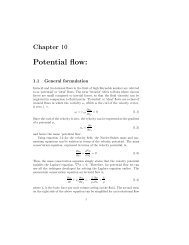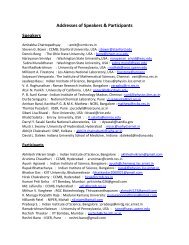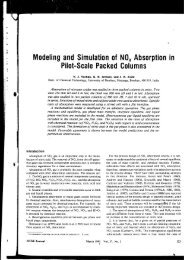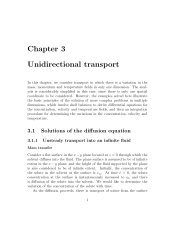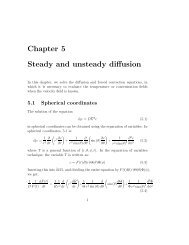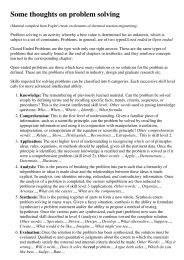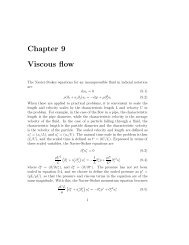Chapter 11 Boundary layer theory
Chapter 11 Boundary layer theory
Chapter 11 Boundary layer theory
You also want an ePaper? Increase the reach of your titles
YUMPU automatically turns print PDFs into web optimized ePapers that Google loves.
8 CHAPTER <strong>11</strong>. BOUNDARY LAYER THEORY<br />
The shear stress at the surface is given by,<br />
τ xy<br />
= µ ∂u x<br />
∂y ∣ y=0<br />
µ du x<br />
=<br />
(νx/U ∞ ) 1/2 dη ∣ η=0<br />
( ) νU<br />
3 1/2<br />
= ρ ∞ d 2 ∣<br />
f ∣∣∣∣η=0<br />
(<strong>11</strong>.37)<br />
x dη 2<br />
Therefore, the shear stress at the surface decreases as x −1/2 as the downsteam<br />
distance x increases. The value of (d 2 f/dη 2 ) = 0.664 at η = 0 is obtained<br />
from the numerical solution of equation <strong>11</strong>.33 for f(η), and therefore the<br />
shear stress at the surface of the plate is,<br />
τ xy = 0.332ρ<br />
( νU<br />
3<br />
∞<br />
x<br />
) 1/2<br />
(<strong>11</strong>.38)<br />
The total force exerted on the plate, per unit length in the direction perpendicular<br />
to the flow, is determined by integrating equation the shear stress,<br />
F x =<br />
The ‘drag coefficient’ is defined as,<br />
∫ L<br />
0<br />
dx τ xy<br />
= 0.664ρ(νU 3 ∞L) 1/2 (<strong>11</strong>.39)<br />
C D =<br />
F x<br />
(ρU 2 ∞ /2)L<br />
= 1.328Re −1/2<br />
L (<strong>11</strong>.40)<br />
where Re L is the Reynolds number based on the length of the plate and the<br />
free stream velocity U ∞ .<br />
<strong>11</strong>.1 Stagnation point flow<br />
The stagnation point flow is encountered at the upstream stagnation point<br />
in the flow past bluff bodies such as solid spheres, where the fluid velocity is





